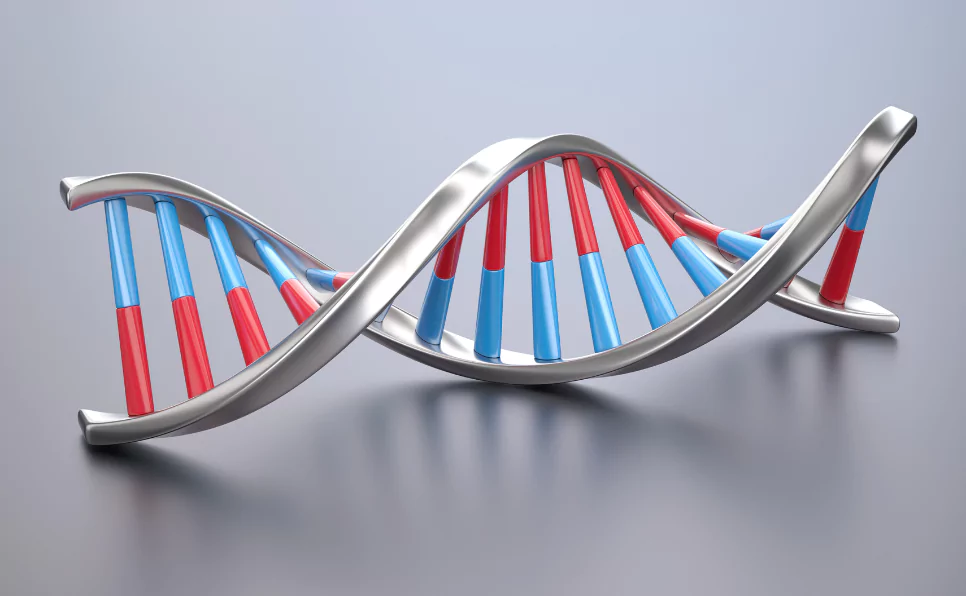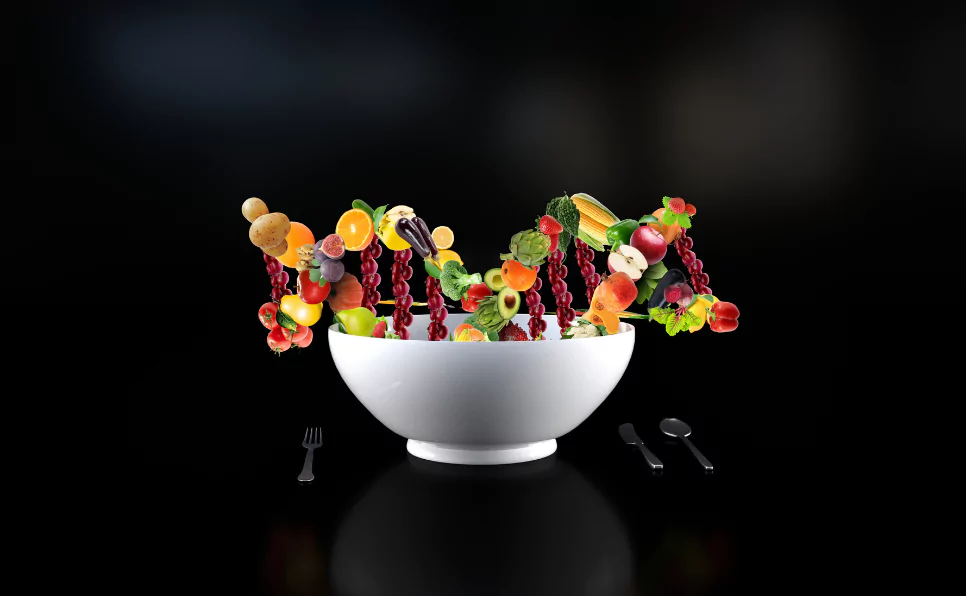What is DNA, anyway? DNA is like a recipe book that every living being carried within itself. It contains guidelines on constructing, maintaining, and mending every living organism’s body.
It’s something that parents pass down to their children, with each parent contributing half of the DNA.
Most of the DNA is kept inside the cell’s control center or nucleus, while a little is found in the cell’s powerhouses, the mitochondria. DNA has a spiral staircase shape, and it’s broken down into sections called chromosomes.
These chromosomes house a specific number of recipes or genes. Every gene carries instructions for creating bits of proteins, entire proteins, or several specific proteins.
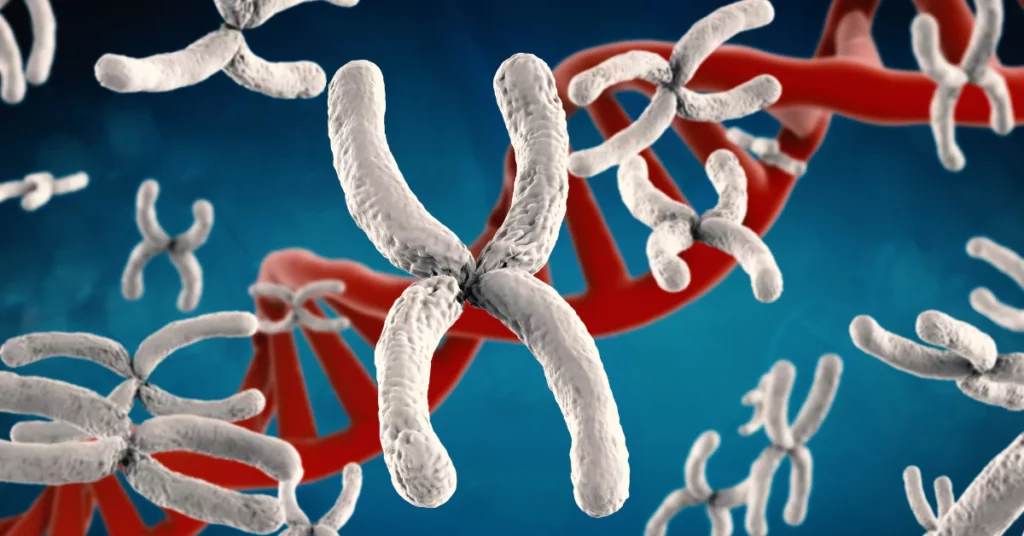
So why should we care about understanding DNA?
Knowing about DNA can reveal our family history, health status, individual traits, and the likelihood of getting certain diseases.
DNA also has other uses, like identifying individuals in criminal investigations, determining fatherhood, making changes at the genetic level, and biotech applications. By unraveling the DNA mystery, we can better understand life and ways to enhance it.
In this article, I’ll delve deeper into the DNA’s structure and function. I will also discuss how research about DNA is changing health care and society.
What is DNA
When asking, “what is DNA?” we’re talking about deoxyribonucleic acid. It’s a special chemical found in all the cells of all living beings and even in many viruses. DNA acts as the blueprint for transmitting traits that are inherited.
DNA’s structure looks like a twisted ladder or a double helix, made up of two DNA strands wrapped around each other. The credit for discovering DNA’s structure in 1953 goes to James Watson and Francis Crick, with crucial help from Rosalind Franklin and Maurice Wilkins.
This discovery revolutionized our understanding of how DNA copies itself and controls activities within cells.
Each strand of a DNA molecule is a long chain made up of units called nucleotides. These nucleotides of DNA are composed of a sugar molecule called deoxyribose, a phosphate group, and one of four nitrogen-containing bases: adenine and guanine (which are purines), and cytosine and thymine (which are pyrimidines).
The nucleotides are linked by bonds formed between the phosphate of one nucleotide and the sugar of the next. This forms a backbone made of phosphate-sugar, with the nitrogenous bases sticking out.
DNA’s role in life is to store, use, and pass on instructions for creating proteins. Proteins are large molecules that perform various tasks in the cell such as triggering chemical reactions, moving molecules, transmitting signals, controlling gene activity, and providing structural support.
The order of nucleotides in a gene dictates the order of amino acids in a protein, which in turn decides the shape and function of the protein.
The Four Genetic Letters: Adenine, Guanine, Cytosine, and Thymine
In the DNA basics, we learn about four chemical compounds called nucleobases or simply bases. These are adenine (A), guanine (G), cytosine (C), and thymine (T) – the letters of the genetic code.
Adenine and guanine have a two-ring structure and are therefore known as purines. Cytosine and thymine have a single-ring structure, so they are called pyrimidines.
These bases can form connections with each other across the two strands of the DNA double helix. But, they only pair with specific partners: adenine only bonds with thymine (A-T), and guanine only bonds with cytosine (G-C). This is known as complementary base pairing.
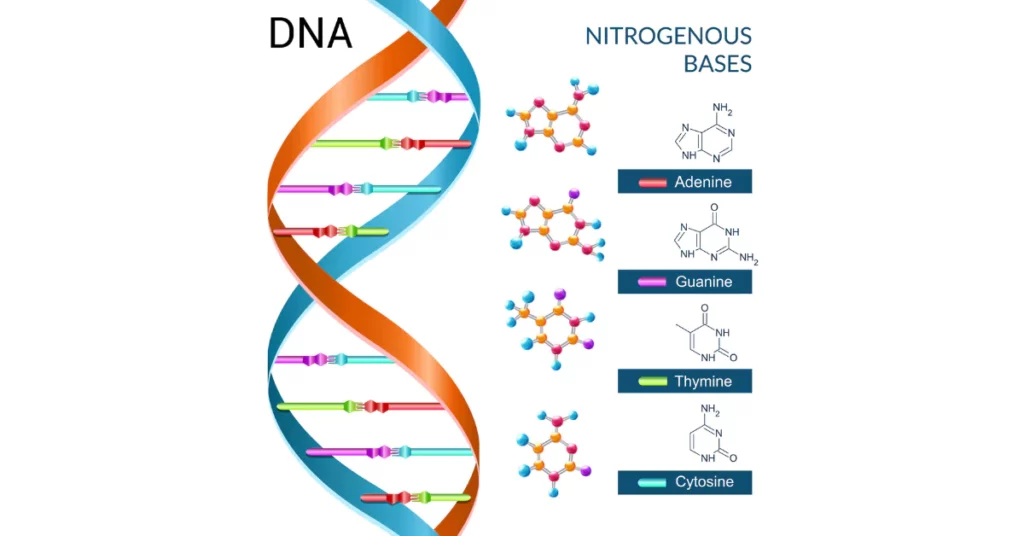
The order of bases along a DNA strand defines the genetic information it carries. Different orders of bases can lead to different proteins or control gene activity. These sequences can also differ among individuals or species, leading to genetic diversity.
For instance, human DNA has about 3 billion bases, and more than 99% of those bases are identical in all people. The remaining less than 1% of bases account for variations in traits, like eye color, blood type, or the likelihood of developing certain diseases.
The base sequences can also change over time due to mutations or changes in the DNA. Some changes can be good, neutral, or bad, depending on how they influence the function of a gene or protein.
These changes can be passed down from parents or can happen during one’s lifetime. These variations contribute to genetic variation and evolution.
DNA Replication: The Basis of Life and Heredity
Now, let’s understand how DNA copies itself, a process known as DNA replication, which happens before a cell splits in two. This is vital because it makes sure each new cell has its own copy of DNA.
DNA replication, which is the foundation of life, is semiconservative. That means every new DNA molecule is half old and half new. DNA replication happens in three major steps: initiation, elongation, and termination.
- Initiation: This is when an enzyme, DNA helicase, begins to untwist the double helix by breaking the bonds between the base pairs. This results in a ‘Y’ shape called a replication fork, where the two strands part ways and serve as templates for new strands.
- Elongation: At this stage, new nucleotides are added to the new strands by an enzyme named DNA polymerase, ensuring they match the bases on the template strands. However, DNA polymerase cannot start a new strand from nothing; it requires a short segment of RNA called a primer, created by another enzyme named DNA primase. Because the two template strands run in opposite directions, they are copied differently. The strand running from 3′ to 5′ is continuously copied by one DNA polymerase and is called the leading strand. The strand running from 5′ to 3′ is the lagging strand and is replicated discontinuously by multiple DNA polymerases. The lagging strand forms short bits, or Okazaki fragments, which are later joined by another enzyme, DNA ligase.
- Termination: This is when the replication process wraps up, and the two new DNA molecules part ways. The RNA primers are removed and replaced with DNA by a different type of DNA polymerase. If there are any mistakes in the replication process, they are fixed by the proofreading function of DNA polymerase, which takes out and replaces mismatched nucleotides.
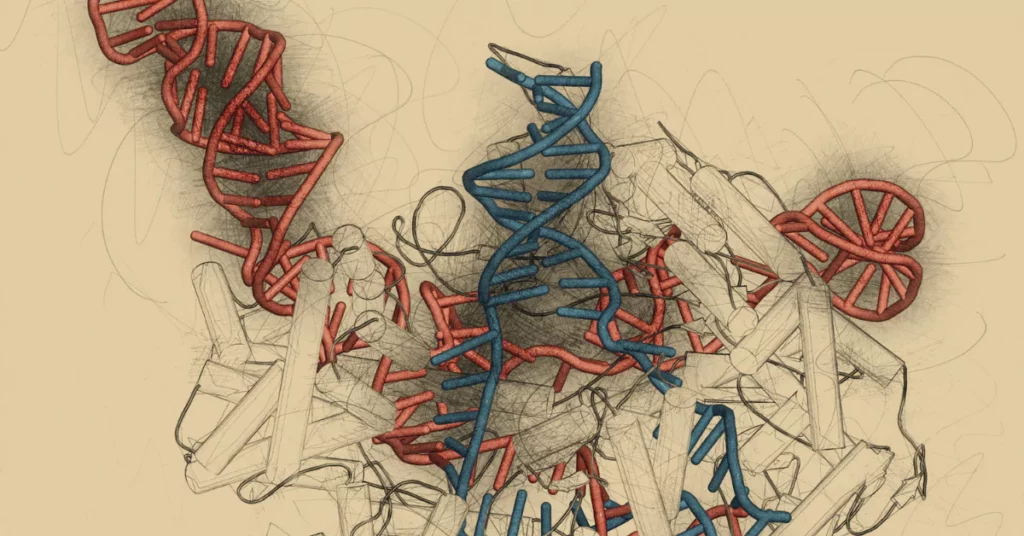
Important Enzymes in Replication
As we have already discussed, several enzymes, each with a specific role, take part in the replication process:
- DNA helicase: This enzyme unwinds the DNA double helix and separates the two strands by breaking the hydrogen bonds between the base pairs.
- DNA primase: This enzyme creates short RNA primers that offer a 3′ end for DNA polymerase to start adding nucleotides.
- DNA polymerase: This enzyme adds nucleotides to the 3′ end of the new strands, ensuring they match the base pairing rules. It also checks its own work and corrects any mistakes.
- DNA ligase: This enzyme links the Okazaki fragments on the lagging strand by forming bonds between them.
Other enzymes also contribute to the process of replication
- Topoisomerase: This enzyme helps unwind the DNA ahead of the replication fork by making temporary cuts in the strands.
- Single-strand binding proteins: These proteins bind to and stabilize the single-stranded DNA at the replication fork to prevent them from recombining.
Importance of DNA replication in cell division and genetic inheritance
DNA replication is crucial for cell division because it ensures that each new cell gets a complete and identical copy of the genetic material from the parent cell. This is what allows living beings to grow, develop, repair damage, and reproduce.
DNA replication also plays a key role in passing down genetic information from one generation to the next. This is because the DNA of a living being contains genes, which are DNA segments that code for proteins or other molecules that determine an organism’s traits. By accurately copying DNA, the genes and the traits they represent are inherited by the offspring.
DNA and Proteins: From Genes to Traits
But what does DNA do, beyond storing genetic information?
It also provides instructions for making proteins. Proteins are large molecules that carry out many different functions in the cell, such as starting chemical reactions, moving substances around, providing structure, regulating gene expression, and more.
Proteins are made up of smaller units called amino acids, linked together in a unique sequence and structure.
Understanding the Idea of a Gene
A gene is a part of the DNA that holds the information to create a protein or a functional RNA molecule (like tRNA or rRNA).
Each gene is found at a particular location on a chromosome, known as its locus. A gene can have different versions or variants, called alleles, which can result in different forms of the protein or RNA.
For instance, the gene for eye color has different alleles that determine whether a person has blue, brown, or green eyes.
The process of transcription and translation
Turning genes into proteins involves two main steps: transcription and translation.
- Transcription: In this step, the information in a gene is copied into a molecule called messenger RNA (mRNA). Transcription is carried out by an enzyme called RNA polymerase, which binds to a specific region of the DNA called the promoter and separates the two strands. Unlike DNA replication, transcription doesn’t require a primer, and only one strand of DNA is used as a template. The strand that is transcribed is called the template strand or the antisense strand, while the other strand is called the coding strand or the sense strand. The coding strand has the same sequence as the mRNA (except for T instead of U). Transcription ends when RNA polymerase reaches a specific sequence on the DNA called the terminator.
- Translation: In this step, the information in mRNA is translated into a sequence of amino acids to form a protein. Translation involves three types of RNA molecules: mRNA, transfer RNA (tRNA), and ribosomal RNA (rRNA). mRNA carries the genetic code from the nucleus to the ribosome, which is a complex of rRNA and proteins that catalyzes protein synthesis. tRNA carries specific amino acids to the ribosome and matches them with the codons on mRNA.
How Genes Determine Traits
Genes determine traits by encoding proteins that influence various aspects of an organism’s structure, function, and behavior. Different alleles of a gene may lead to different forms or levels of a protein, resulting in different phenotypes or observable characteristics of an organism.
However, it’s important to note that not all traits are determined solely by genes; environmental factors, such as nutrition or exposure to chemicals, also influence some.
Therefore, genes influence the likelihood of developing a certain trait, but they aren’t always the sole determinant.
Genetic Variation and Mutation: The Role of DNA in Evolution and Disease
Importance in evolution
Like we learned earlier, different gene versions, known as alleles, can lead to different traits – like whether you have blue or brown eyes or type A or type O blood.
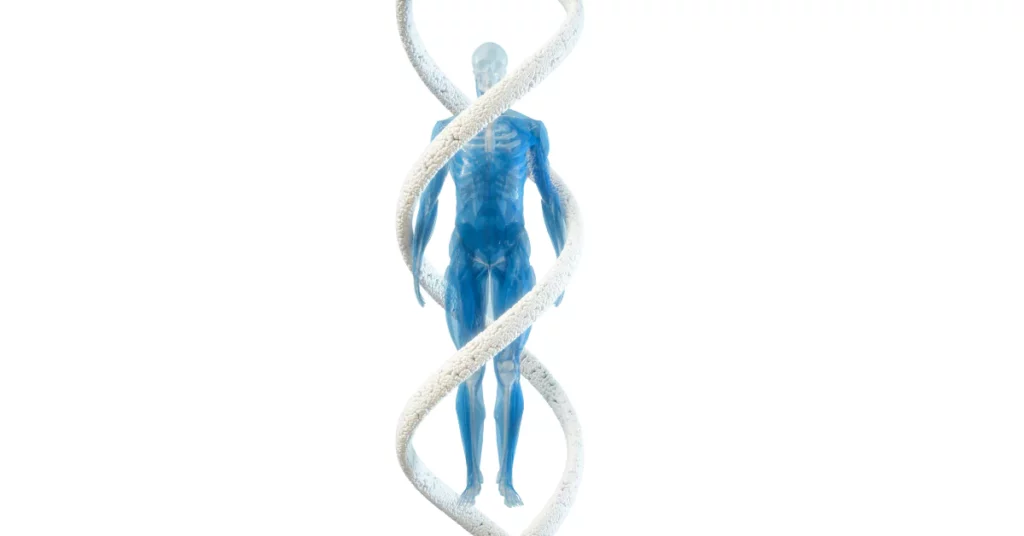
The importance of genetic variation in evolution is that it’s the raw stuff for natural selection. Natural selection is nature’s way of deciding who can survive and have babies based on their traits.
If a DNA change or variation gives an advantage to an individual, that individual is selected due to better fitness. While if a mutation causes severe disease, that individual has less chance of survival, so his genes are not passed on to the next generation.
Over time, this changes the types of traits and alleles in a group and eventually can even create new species.
Genetic variations and their potential impacts
A DNA variation is a change in the building blocks, called nucleotides, of a strand of DNA. Changes can happen randomly due to mistakes when DNA is being copied or fixed, or outside things like radiation or chemicals can cause them.
Different types of variations can have various effects on how genes function and express themselves.
Here are a few common types of variations:
- Silent changes: This is a change that doesn’t affect the protein recipe in the gene. So, it doesn’t change the creature’s traits.
- Missense changes: This change causes a different part to be put into the protein. This can change how the protein works or what it looks like, depending on how critical the changed part is.
- Nonsense changes: This change makes a stop signal in the protein recipe. It’s like hitting a wall in the middle of building something – you end up with a half-built, non-working protein.
- Frameshift changes: This is like taking out or adding a piece to a DNA strand, which changes how the rest of the gene is read. This results in a completely different protein, which is usually non-working.
- Splice site changes: This change messes with the gene editing process. It can cause parts of the gene to be skipped or left in, changing the final protein.
The effects of genetic changes on health can vary. It depends on if the mutation happens in body cells or reproductive cells and whether it changes how critical proteins work. Some mutations can cause illnesses like cancer or genetic disorders like cystic fibrosis.
Role of DNA in Genetic Diseases?
DNA determines traits and characteristics by coding proteins that do various things inside cells and tissues. DNA is also involved in genetic diseases, illnesses caused by gene or chromosome abnormalities. During replication, cell division, or due to external forces, mutations may arise that may lead to the disease phenotype.
Genetic diseases can be divided into three main groups:
- Single-gene disorders: Illnesses caused by mutations in one gene that affect how it works or expresses itself. Examples include sickle cell anemia, hemophilia, and Huntington’s disease.
- Chromosomal disorders: Illnesses caused by changes in the number or shape of chromosomes, which carry genes. Examples include Down syndrome, Turner syndrome, and Klinefelter syndrome.
- Complex disorders: Illnesses caused by multiple genes and environmental factors affecting their expression. Examples include diabetes, hypertension, and Alzheimer’s disease.
Genetic diseases can be diagnosed in various ways, such as family history, physical exams, biochemical tests, and genetic tests. Genetic tests look at DNA samples to find mutations or chromosomal abnormalities. They can be used for various purposes.
Human Genome Project
The Human Genome Project was a big international research project aiming to sequence and map all the human genes, which are made up of around 3 billion building blocks and 20,000 to 25,000 genes. It began in 1990 and finished in 2003 and involved thousands of scientists from all around the world.
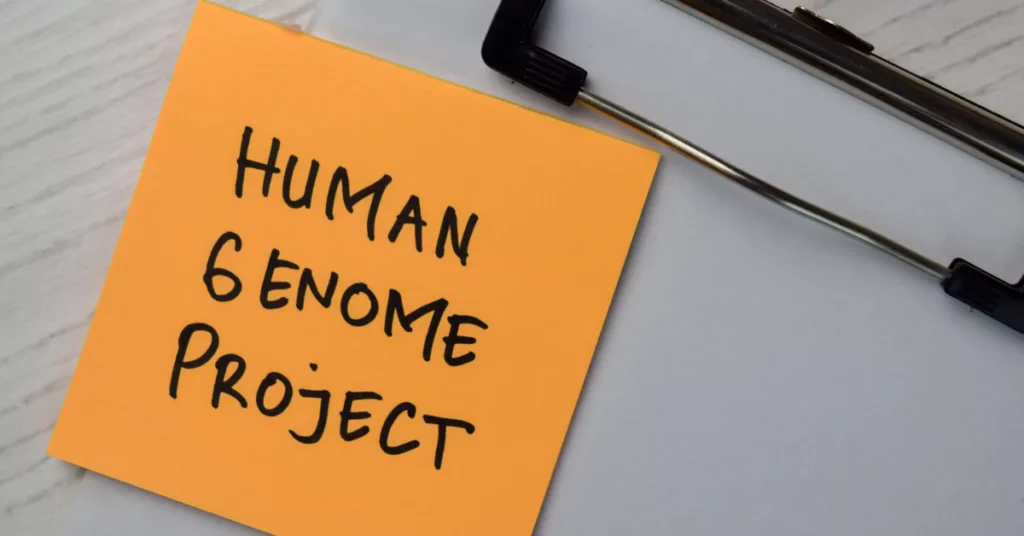
The main goals of the project were to:
- Identify all the genes in the human genome and understand what they do and how they interact.
- Understand the differences and similarities among different humans.
- Compare the human genome with the genomes of other creatures and understand how humans evolved.
- Develop new technologies and tools for genomic research and medicine.
Why is Understanding the Human Genome Important?
Understanding the human genome is beneficial for science, medicine, and society. Some applications and outcomes of the project are:
- Improve the diagnosis, prevention, and treatment of genetic diseases by identifying the involved genes and mutations.
- Develop new drugs and therapies that are personalized to each individual’s genetic makeup, also known as personalized or precision medicine.
- Enhance knowledge of human biology, physiology, development, and diversity.
- Advance biotechnology, bioinformatics, and bioethics fields.
What is Personalized Medicine and Gene Therapy?
Personalized medicine is a method that uses genomic info to personalize medical care for each individual. Personalized medicine aims to:
- Predict the risk of certain diseases based on genetic factors.
- Choose the best treatment for each patient based on their genetic makeup.
- Monitor how effective and safe drugs are by measuring their effects on gene expression or activity.
Gene therapy is a type of personalized medicine that involves adding or changing genes to treat or prevent diseases. Gene therapy can be used to:
- Replace a faulty or missing gene with a normal one.
- Add a new gene that can produce a useful protein or enzyme.
- Silence or inhibit a harmful gene.
Gene therapy can be delivered in various ways, like viral vectors, non-viral vectors, or gene editing tools. It’s still a new and experimental field with challenges in safety, efficiency, ethics, and regulation.
Decoding DNA: Techniques and Technologies
Traditional techniques: PCR, Gel Electrophoresis, Sanger Sequencing
Sanger sequencing, a method that’s been around since the late ’70s, is often used to decode DNA. It involves several steps:
- The DNA sequence we’re interested in is copied many times over in a process called PCR (polymerase chain reaction). This uses special enzymes and tiny DNA pieces, called primers, to make many copies of the DNA strand of interest.
- The resulting DNA pieces are then separated by their size using gel electrophoresis. DNA is negatively charged, so an electric field moves these molecules through a gel. The smaller the DNA fragment, the quicker it moves.
- The order of the DNA fragments is figured out by checking what kind of unit (the A, T, C, or G we mentioned earlier) is at the end of each piece. The process for this varies slightly depending on the technology used, but the gist is the same: match the color of a label to a unit to get the sequence.
This technique is great for looking at smaller bits of DNA, up to about 900 base pairs (units) long.
Modern Techniques: Next-Generation Sequencing, CRISPR-Cas9
Traditional methods like Sanger sequencing have their limits. They can be slow, expensive, and labor-intensive. That’s why scientists developed new ways to study DNA. These new techniques, collectively known as next-generation sequencing (NGS), can sequence much larger amounts of DNA quicker and cheaper than older methods.
There are a few different types of NGS methods, each with their unique benefits and drawbacks:
- Illumina sequencing: This method creates many identical DNA fragments on a flow cell and then reads their sequence using fluorescently labeled units. A camera detects the fluorescence after each synthesis cycle.
- Ion Torrent sequencing: This method attaches millions of DNA fragments to tiny beads and reads their sequence by measuring the pH changes that happen during synthesis.
- Nanopore sequencing: This method uses electric current to read the sequence of single DNA molecules as they pass through a tiny hole.
NGS methods have many uses, such as sequencing entire genomes or parts of the DNA that control how and when genes are turned on and off (the epigenome).

CRISPR-Cas9, another modern technique, has revolutionized the way we can edit genomes. The system, which consists of a protein called Cas9 and a guide RNA, can cut the DNA at any location specified by the guide RNA.
This creates breaks that the cell’s own repair machinery fixes, leading to changes in the DNA sequence. This method can be used to study gene function, treat genetic diseases, and develop new biotechnology products.
Future of DNA Technologies
DNA technologies are always evolving, offering new opportunities for science and society. Future developments in DNA technologies might include:
- Discovering new types of the CRISPR system: Besides Cas9, there are many other types of CRISPR systems. These systems have a wide range of applications in genome editing and gene regulation, among others.
- Developing base editors and prime editors: These are modified versions of the CRISPR system that can directly change one DNA base to another without creating breaks in the DNA.
- Advancing single-cell sequencing: This technology can sequence the genome of individual cells, revealing the diversity and dynamics of cell populations in different tissues and organisms.
- Applying synthetic biology: This field aims to design and construct new biological systems or modify existing ones. It can use DNA technologies to create artificial genes, circuits, or genomes that perform novel functions in living cells or organisms.
Final Words
In a nutshell, DNA is like the instruction manual of life, influencing everything from our eye color to our susceptibility to certain diseases. It replicates itself, makes proteins, and even plays a role in our species’ evolution.
Our growing ability to “read” and understand this code opens up exciting possibilities, such as personalized medicine and gene therapy. The more we understand about DNA, the more we can harness its potential to improve human health and well-being.
Like any complex language, learning takes time, but each new discovery brings us one step closer to unlocking its mysteries.
References:
- https://medlineplus.gov/genetics/understanding/basics/dna/
- https://www.britannica.com/science/DNA
- https://www.thoughtco.com/dna-replication-3981005
- https://www.genome.gov/genetics-glossary/DNA-Replication
- https://link.springer.com/protocol/10.1007/978-1-0716-2501-9_13
- https://www.frontiersin.org/articles/10.3389/fmolb.2021.816398/full
- https://medlineplus.gov/genetics/understanding/mutationsanddisorders/evolution/
- https://www.britannica.com/science/evolution-scientific-theory/Genetic-variation-and-rate-of-evolution
- https://www.nationalgeographic.org/encyclopedia/genetic-variation/
- https://www.verywellhealth.com/what-is-a-mutation-5092230
- https://www.britannica.com/science/mutation-genetics
- https://geneticeducation.co.in/genetic-mutations-definition-types-causes-and-examples/
- https://openoregon.pressbooks.pub/mhccmajorsbio/chapter/types-of-mutations/
- https://my.clevelandclinic.org/health/body/23095-genetic-mutations-in-humans
- https://www.nature.com/scitable/topicpage/genetic-mutation-441/
- https://www.thermofisher.com/us/en/home/life-science/sequencing/sequencing-learning-center/capillary-electrophoresis-information/what-is-sanger-sequencing.html
- https://www.nature.com/articles/s41580-019-0131-5
- https://www.ncbi.nlm.nih.gov/pmc/articles/PMC7079207/
- https://pubmed.ncbi.nlm.nih.gov/35331236/
- https://molecular-cancer.biomedcentral.com/articles/10.1186/s12943-022-01565-1
- https://www.ncbi.nlm.nih.gov/pmc/articles/PMC8944095/

Dr. Sumeet is a seasoned geneticist turned wellness educator and successful financial blogger. GenesWellness.com, leverages his rich academic background and passion for sharing knowledge online to demystify the role of genetics in wellness. His work is globally published and he is quoted on top health platforms like Medical News Today, Healthline, MDLinx, Verywell Mind, NCOA, and more. Using his unique mix of genetics expertise and digital fluency, Dr. Sumeet inspires readers toward healthier, more informed lifestyles.

